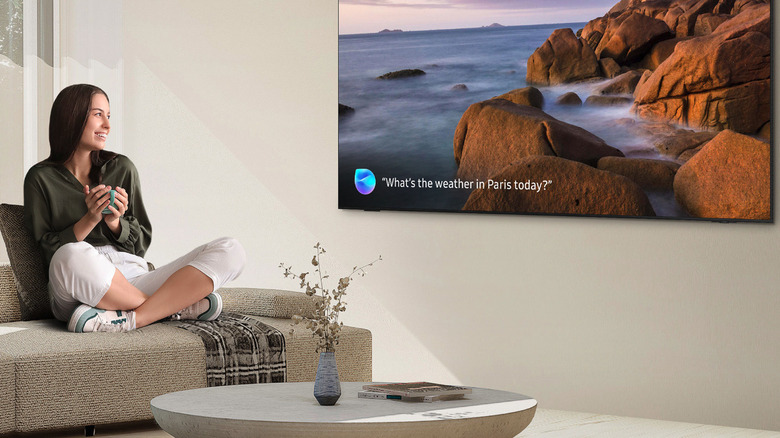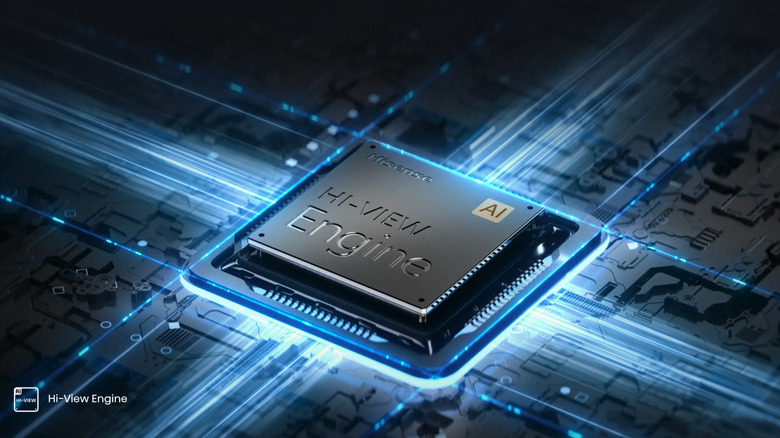Are AI TVs The Future Or Just A Flashy Upgrade?
We may receive a commission on purchases made from links.
As hard as it may be to believe, in just a few short years, artificial intelligence (AI) has found its way into most of our daily lives. Even if we don't actively use chatbots like Gemini or ChatGPT, there's a good chance we use AI-powered tech at some point during the day. From the Apple Intelligence features that have changed the way many of us interact with our iPhones, MacBooks, and iPads to image generation tools that can make one feel like they're the next Picasso, for many of us, AI has become a part of how we work, create, or even entertain ourselves. So, it comes as no surprise that AI is making its way into our living rooms, as TV manufacturers rush to incorporate the technology into their latest models.
What you may not know is that AI has been used in TVs for quite some time, with companies like Samsung using it to improve picture sharpness and upscale lower-resolution content. What's new is its ability to make real-time adjustments to picture, sound, and even content based on what you're watching. If you've spent any time shopping for a new TV this year, there's a good chance you've already taken notice of the AI trend, as more and more manufacturers put AI front and center in product names, ads, and feature lists for mid-range and high-end TVs. Nobody could blame you for thinking all of this AI hype is just a passing fad. However, the truth is that these features are here to stay, and over time, the technology will make its way to even the most affordable TVs.
AI TVs improve upon existing features and add more personalization
If you look closely at the AI feature set that comes with this year's TVs, you'll notice something interesting: AI isn't doing anything life-changing; instead, it's making existing features better. For example, AI-driven upscaling utilizes deep learning to enhance low-resolution content, resulting in sharper, more detailed images on high-resolution screens. One example is LG, whose TVs ranked number one on our list of 16 major TV brands. The company's Alpha 11 processor utilizes AI to reduce noise and enhance sharpness, allowing even complex scenes to remain crisp and clear.
Another thing AI can do for a TV is adjust its picture settings in real-time based on the content being displayed. That means whether you're watching a dark thriller or a colorful animated film, the TV will adjust the brightness, contrast, and color to fit what you're watching, without you having to do a thing. Samsung's Vision technology, as found on the 55-inch OLED 4K Vision AI TV, offers a glimpse into how it works, dynamically adjusting display modes to match different content genres.
AI can also enhance your TV's audio by analyzing it in real-time and adjusting the sound settings to make the dialogue clearer and the listening experience more immersive. Samsung's Adaptive Sound Pro does something similar by adjusting the audio based on the room and what you're watching. Beyond the improvements to screen and audio quality, AI TVs deliver a more personalized viewing experience. Some TVs, like the 55-inch LG OLED B4 4K Smart TV, use voice recognition to identify who's watching and customize home screens with content recommendations based on personal viewing habits.
AI features are becoming more common across price ranges
For now, the most advanced AI features are limited to mid-range and high-end TVs. However, if the current prices don't fit your budget, there's a good chance they'll drop over the next few years. Just like standard TVs have become cheaper as the technology has evolved, the same thing will likely happen with AI-powered models. In fact, some features are becoming increasingly common across a range of models and price points. While it's true that you won't find features like real-time scene optimization, personalized content recommendations, or voice recognition on a budget model, basic AI enhancements can still be found among affordable options.
For example, the Hisense 65-inch Mini-LED ULED Google Smart TV retails for $499.99 on Amazon and comes with the Hi-View AI Engine, which uses deep learning and technologies like Dynamic Tone Mapping Pro and Face Detection to enhance screen quality. While this Hisense TV isn't exactly cheap, it's an example of how prices are slowly but surely beginning to come down for TVs with AI features. Another example is Samsung's AI Energy Mode, introduced in 2023 and now available on many of the company's Smart TVs released after that date. When it comes to truly budget-priced TVs, AI functions are typically limited, and we can likely expect to wait a few more years before they catch up to what high-end models can do today.


